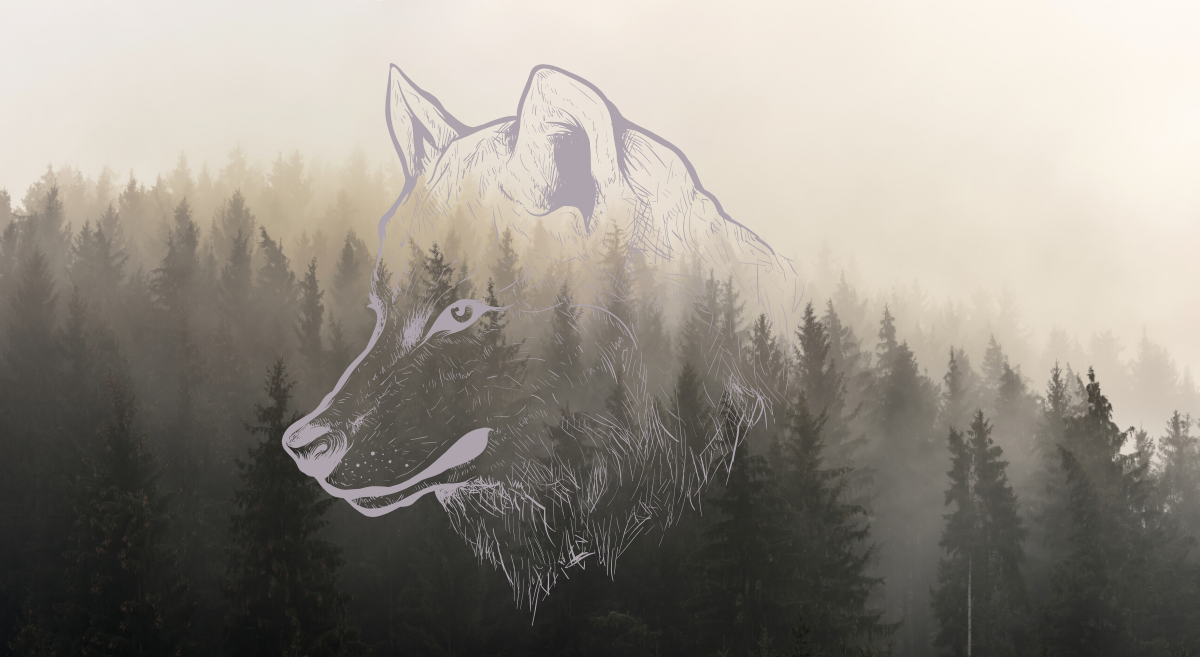
On April 15th, the Oregon Department of Fish & Wildlife (ODFW) released their annual wolf report. As usual the agency put a positive spin on their program, but unlike recent years, the news was legitimately generally positive. In 2019, the state did not kill wolves, the wolf population grew, and conflict with livestock decreased. Those are outcomes we've been fighting for for years.
However, we also saw population growth generally align with ODFW’s worst-case projection model. An alarming number of wolves were hit by cars. And, there remains only one known breeding pair west of the Cascades.
What got the most attention in the report was something the agency did not document. The report noted that OR-7 aka Journey had not been seen in months. OR7 wouldn’t be the first Imnaha wolf to go missing for a long time only to surprise us and reappear (father OR4 and big brother OR3 did so). However, given his age, it seems very likely OR7's historic journey has come to an end.
A few months ago I did an interview with Jay Simpson of the OR7 Expedition. I managed to dodge the question he most wanted an answer to. Ten years after his history making Journey - what was OR7’s legacy to me.
I’ve written a few eulogies for Oregon wolves over the years. Given that there was once a stage play written about OR7 in which we were both characters, it seems like this should have been the easiest one of all. Maybe I'm eulogied out. But for whatever reason, I struggled to find words – or even identify the feelings to put into words.
So I asked some of my colleagues for their thoughts. Once the news came of OR7’s likely death, I reached out to other people who had been affected by Journey. The list included ranchers, wildlife biologists, activists, artists, journalists and more. Below are some of the responses we received.
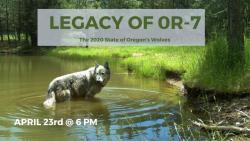 In case you missed it, Oregon Wild recently broadcast a webinar on the legacy of OR7 and the history and status of wolves in Oregon. |
Beckie Elgin, author, Journey – the Amazing Story of OR-7
OR-7, better known to me as Journey, has for many years been my four-legged muse.
Around the time he dispersed from Northeastern Oregon, I began to research and write about wolves in our state. Journey became my focus, and eventually I created a book about him. His long and meandering trek to Southern Oregon, where I live, inspired not only my writing, but also my wanderlust.
I spent many memorable days traveling to remote areas he was known to have been, just to feel his presence and perhaps see a track or some scat. I talked to a lot of folks on these trips, and learned that it was the minority who didn’t want wolves back. Most held the iconic predator in high regard and appreciated living in a land wild enough to house wolves. And the wolves did come, in great part because of Journey. He led the way for others to disperse down here, and his legacy lives on in his offspring that thrive in the forest of Southern Oregon and Northern California, and perhaps elsewhere as well.
I will grieve for the loss of Journey, but I will also be thankful that he lived a long and natural life, not one cut short by human hands. And I’ll be forever grateful for the inspiration he provided me and so many others.
Beckie Elgin is the author of Journey: the Amazing Story of OR-7, the Oregon Wolf that Made History. She also has a blog – Wolves and Writing - check it out!
Steve Pedery, Conservation Director, Oregon Wild
As published in the Oregonian:
 In 2011, OR-7 was the wolf his species needed. That was a brutal year for wildlife advocacy in Oregon. We had just come off the 2010 Oregon Wolf Conservation and Management Plan revision, where 20,000 public comments were submitted, 90% in favor of greater protection, but they did little to influence the Oregon Department of Fish and Wildlife and the commission that oversees it. In the Legislature, anti-wildlife politicians and agribusiness lobbyists pushed bills to make it easier to kill wolves. And far-right conspiracy theories were circulating about “Canadian” wolves invading Oregon and making it too hard for hunters to bag a trophy elk. At the time, there were just four known packs and two breeding pairs of wolves in the entire state.
In 2011, OR-7 was the wolf his species needed. That was a brutal year for wildlife advocacy in Oregon. We had just come off the 2010 Oregon Wolf Conservation and Management Plan revision, where 20,000 public comments were submitted, 90% in favor of greater protection, but they did little to influence the Oregon Department of Fish and Wildlife and the commission that oversees it. In the Legislature, anti-wildlife politicians and agribusiness lobbyists pushed bills to make it easier to kill wolves. And far-right conspiracy theories were circulating about “Canadian” wolves invading Oregon and making it too hard for hunters to bag a trophy elk. At the time, there were just four known packs and two breeding pairs of wolves in the entire state.
Then we all learned about this young male wolf with a tracking collar, leaving behind his family in the Imnaha Pack in far Northeast Oregon and heading southwest. At the time, most wolf watchers found his story interesting, but sad. The wolf, called OR-7 by biologists, was heading into a part of Oregon where wolves were hunted to extinction 70 years prior, and we all believed there was little chance he'd find a mate there, even if he survived the trip.
But he persevered, and with some help from conservation groups, the public started to become aware of him. There was a naming contest, regular updates in the news media, art contests for kids and even semi-regular cartoons in the Oregonian newspaper. OR-7 – who became known to many as Journey as a result of the contest – had no idea he had become a celebrity to humans, nor would he have cared, but across the thousands of miles he traveled he captured the hearts and minds of millions of people. I think a huge part of it was that his story was deeply relatable.
He amazed us all with his tenacity, endurance, and intelligence as he traveled across a landscape that had not seen a wolf in over half a century. He had to hunt and scavenge for food, find water and avoid human poachers, cars and highways. He crossed high desert sagebrush, ponderosa pine forests and snow-capped mountains, swam rivers and survived harsh winters. He crossed into California, took advantage of a forest fire to hunt and find prey, then returned north to the forests around Crater Lake, one of the largest wild areas left in the Cascades. And he did it all while almost entirely avoiding contact with humans, despite there being many, many people, from biologists to bird watchers, doing their best to take his picture. Without his tracking collar, humans would never have known he did any of this.
 When the news came that he had found a mate and had started a pack of his own, it really gave people a sense of hope and of human redemption. Here was this wolf who had traveled and survived across thousands of miles of unfamiliar country, into places where humans hunted his species to extinction. He didn’t just survive, he thrived, found a mate, and settled down. It was very fitting that the area they chose for their home territory was the place where the last known wolves in Western Oregon were killed in the 1940s.
When the news came that he had found a mate and had started a pack of his own, it really gave people a sense of hope and of human redemption. Here was this wolf who had traveled and survived across thousands of miles of unfamiliar country, into places where humans hunted his species to extinction. He didn’t just survive, he thrived, found a mate, and settled down. It was very fitting that the area they chose for their home territory was the place where the last known wolves in Western Oregon were killed in the 1940s.
OR-7 changed the narrative. There are still plenty of people in Oregon who demonize wolves, who see them as something that their great great grandaddy killed off for good reason, or as part of some big government conspiracy, or as terrible animals who cut into the number of elk tags available to sell. Those people are still around, some of them in decision-making positions that affect wildlife policy. But for most of us, I think OR-7 changed how we think about wolves and about our relationship with them and with wild places. He symbolized redemption and the hope that if humans could get beyond their fear, nature and wildlife can recover and thrive.
State biologists said last week that OR-7 wasn’t among those spotted during the annual wolf count. Although his mate is still in the pack’s territory, OR-7, now about 11 years old, was last photographed in the fall. That’s a fairly old age for a wild wolf.
We don’t know for sure if OR-7 is dead. But If he is, I hope he passed somewhere in the wild forests around Crater Lake, and in the territory he reclaimed for his species. And far, far away from human eyes.
|
|
Ester Curini, Artist
Journey's amazing story touched so many hearts and inspired many people to raise awareness about the plight of the wolves. He took back land that belonged to his ancestors. May his epic journey serves us as a reminder to commit ourselves to find a better way of coexistence with this magnificent and essential species.
His courage and perseverance must have been passed on to him by his extraordinary father, OR4.
Ester Curini did an art installation in Brooklyn, NY honoring OR-7’s father, OR4.
Rachael Pecore – Valdez, Lead Organizer, OR7 Expedition
Thank you Wolf OR-7 for showing me a whole, new appreciation of the Northwest as one continuous land, unbroken by the various jurisdictions on a map.
Rachael organized and led the OR7 Expedition and documentary which you should watch here!
Danielle Moser, Wildlife Coordinator, Oregon Wild
He has taught me a new way to look at wolves and the beauty of Oregon. Because of his fame, there have been several children's books written about him, and one of my favorite things to do is sit down with my two little boys and read about Journey.
Journey has provided the world a positive way to tell stories about this unique, charismatic species and the terrific landscapes across Oregon. Even now, when my kids see a picture of Crater Lake...they recognize it as Crater Lake, sure, but what they often say is, "hey mom look, that's where Journey went by on his way across Oregon!". So I would say that Journey's legacy is about reshaping how we learn and tell stories about wolves.
I have to say, I teared up a little this morning when I was listening to the OPB story about Journey and my boys started asking what happened to him?! Hearing the story also launched us into a discussion about death...which is a super fun conversation to have with your kids when you're caught off guard and before the caffeine kicks in. :-)
But in all seriousness, talking to my sons about Journey's life and (possible) death this morning really brought to light how everything in life comes full circle.
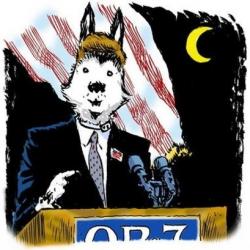 Arran Robertson, Communications Manager, Oregon Wild
Arran Robertson, Communications Manager, Oregon Wild
Journey predates me, so I can't speak to what his legacy is to ME. But, for the movement and for connecting people to the movement, Journey leaves a very important legacy.
One of the things that is important in communications, especially advocacy communications, is storytelling. People connect with stories, their values are often expressed most intimately through stories.
When I think about why I am upset with the livestock industry, yes, I can talk about bad policy and bad environmental outcomes and the waste of money, but the most impactful thing is the story I heard from Washington about how, at a livestock conference, there was a panel on non-lethal and grizzly bears. One presenter talked about how fire hoses with cold water were an effective deterrent for bears. Another presenter quipped "well, it works on the blacks and the indians" and the room erupted in laughter. That story has more impact than any of the substantive criticisms I have of the industry and its players.
Stories have characters and conflict. There is a narrative. Journey's legacy was creating the narrative of wolf recovery, making a story and a struggle that people could connect with. It helped give people a vehicle whereby they could learn about ecology, policy, and history.
This has always been a struggle for the environmental movement. Sociologically, our stories are about people -- or things that act and think like people. The environmental movement, or our wing of it, is not human-centric. In fact, it tries to preserve the sacred parts of the world where humans don't dominate, where we try to keep humanity on a level with the natural world. But that runs counter to thousands of years of how we have learned to communicate and build a civilization.
Journey, or more accurately, the story of Journey, built a bridge between the natural world and the human world of stories, and in that way, helped a lot of people cross the chasm to another point of view.
Amaroq Weiss, Senior West Coast Wolf Advocate with the Center for Biological Diversity.
As 2011 came to a close, it did so with a long joyful howl. On December 28th, 2011, a young male wolf known as OR-7 (aka "Journey"), lifted a paw on the Oregon side of the border and set it back down in California. In that moment, he became the first wild wolf confirmed in our state in 87 years, signaling the return of a species we once drove to extinction.
Journey's incredible odyssey, over 4,000 miles long, brought him from his birthplace in northeastern Oregon to California, where he ranged across seven different counties. He made his way across state, federal and private lands in both states, yet remained almost unseen by anyone. We could follow his travels, however, due to a GPS radio-collar placed on him by state biologists seven months before he left his Oregon pack.
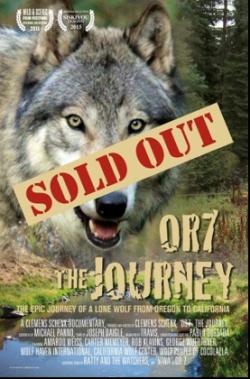 For Californian's, this wolf's journey was our journey. His howl ringing out in the cold mountain air was our own howl of joy at his presence. No other species embodies the magnificence, grandeur and power of nature like the wolf. A rangy, intrepid animal, wolves beguile us with their grace and spirit. Over millions of years, wolves have been the driving force that pushed deer, elk and caribou to become so fast, so strong, so agile, that they are a match for the wolf. No one animal can be said to shape nature on its own, to exert the sole balancing force on the landscape, but if wild nature were an athletic event the wolf would be crowned as its most valuable player.
For Californian's, this wolf's journey was our journey. His howl ringing out in the cold mountain air was our own howl of joy at his presence. No other species embodies the magnificence, grandeur and power of nature like the wolf. A rangy, intrepid animal, wolves beguile us with their grace and spirit. Over millions of years, wolves have been the driving force that pushed deer, elk and caribou to become so fast, so strong, so agile, that they are a match for the wolf. No one animal can be said to shape nature on its own, to exert the sole balancing force on the landscape, but if wild nature were an athletic event the wolf would be crowned as its most valuable player.
When OR-7 -- a member of a native species absent for nearly nine decades -- walked into our State, he handed us a potential conservation success story. His birth in Oregon and travels to California were made possible by protections for wolves under the federal Endangered Species Act, and his coming to California led the state to protect wolves under our own endangered species act. With the arrival of several additional wolves since that time, that conservation story is still in its infancy.
Though OR-7 returned to Oregon, where he finally found a mate with whom he raised litters of pups five years in a row, his legacy continues in the Golden State. At least three of Journey’s offspring have made their way into California on their own.
One became the breeding male of the Lassen pack, the only California pack currently in existence (the state’s first confirmed pack, the Shasta Pack, mysteriously disappeared a few months after their discovery in 2015). The Lassen pack had three litters of its own in 2017, 2018 and 2019 before the breeding male himself disappeared; the pups from each of those litters are OR-7’s grandpuppies. Another of his offspring appeared in Siskiyou County in January 2017, though we do not know if she is still here or even still alive, since she was not radio-collared. A third offspring, OR-54, ventured into California in January 2018. Since she was radio-collared, we knew of her arrival and that she remained mostly in our state until early 2020, when she was found dead. Her cause of death has not yet been made public but many of us are concerned she may have been illegally killed. In her own journeys, OR-54 had traveled nearly 8,000 miles -- twice as many as her famous father -- in search of a mate.
The public fell in love with OR-7 and his life has been a source of hope and inspiration. If he has passed on, as Oregon state wildlife biologists have recently suggested may be the case, it would not be surprising since it is rare for wolves in the wild to reach such a venerable age. And if he did slip away from the family he formed, the Rogue pack, and die peacefully, that would be comforting news: a quiet, non-sensational death, on his own terms and not due to some human action. If/when he is gone, he will have left an indelible mark in the history of wolf recovery. His life and life story contributed significantly to human understanding of wolf biology and ecology and the important role legal protections play for wolf recovery to be successful.
Emma Smith, author, Journey, the True Story of OR-7
OR7 has been a huge part of my life since I first heard about him, around 2014. I was an aspiring children's book writer, and when I read about his story in the newspaper, I knew that here was something rare and special.
Rarely do real-life stories come along that are so emotionally satisfying. Everything about OR7's life, background, and travels was surprising and remarkable. This wolf had grit, pluck, and bravery--if I can allow myself to anthropomorphize for a moment.
He defied all expectations. He became the first wild wolf back in California in almost a century. He found a mate when people thought he would die alone. He lived for over a decade--years longer than the average. And he captured the hearts of the world with the multiple litters of adorable pups that he fathered, helping to repopulate this part of the country. He became a grandfather wolf!
I have read my book about OR7 to countless classrooms of children, and in front of auditoriums of teachers, librarians, and editors. I never fail to almost tear up when I get to the end, the magic moment when we see his mate and his pups, when we learn that he has been successful, against all odds, in his quest. The children never fail to gasp in delight. Their questions, after the read-aloud, go on forever, until a teacher has to shut them down: How old is Journey now? Which pup is your favorite? Why doesn't his mate have a name?
I have had parents tell me they have had to read the book over one hundred times to their child, that their children force them to act out OR7's story. His legacy is strong. He ignited the imaginations of a generation of children and taught them about the importance of sharing our world with the creatures who were here before us.
What started for me as a writing project became far more than that. I will always think of OR7 with a fierce, protective, and grateful love. He changed my life. He will be missed.
Emma Smith is the author of Journey: Based on the True Story of OR-7
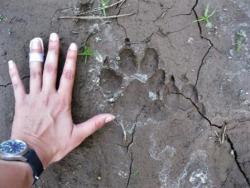 Apple Goeckner, Program Manager, ENR Center at Oregon Law, Former Oregon Wild intern
Apple Goeckner, Program Manager, ENR Center at Oregon Law, Former Oregon Wild intern
Journey, wolf- OR 7, was the most famous wolf I ever knew. He led the movement of wolves into the Cascades and helped influence California to protect wolves on a state level. His adventures are well known through the radio collar that told us his movements for the large part of four years, until the batteries died when he was grown and had pups of his own. It is not often that you see a wolf make international headlines just for simply being a wolf-roaming long distances and making his way through the wild terrain of the West.
The fact that Journey was the first wolf in Western Oregon since 1947 and the first wolf in California since 1924 tells you that there is a much larger story than of just a singular wolf for his natural movements into his proper habitat to be seen as such a huge phenomenon. The eradication and recovery of wolves in the continental U.S. is a story of how humans interact with and manipulate their own environments, a story of using science to learn that we might have been wrong in our past policy decisions, and it is a story of redemption, as we see lands and ecosystems reclaimed by species that were long absent from the landscape.
Journey’s odyssey of crossing from the Northeast corner of Oregon, trekking over a thousand miles into Southwest Oregon and Northern California, and finding a mate in the Southern Oregon Cascades was followed by individuals across the globe. As long as you are able to hear a wolf howl in the western Oregon, you are listening to Journey’s legacy. Journey invoked a sense of inspiration for many of us, both those involved in Western wolf recovery and those unfamiliar with the history of the wolf in the U.S. I will consider Journey a piece of Oregon history and folklore as the wolf that paved the way for the Cascades to echo with a wolf pack’s howl once again.
Galeo Saintz, Founder World Trails Network, IUCN Co-Chair of CEESP Theme on Environment and Peace, and OR7 Expedition Development Coordinator
During the OR-7 Expedition, I wrote a poem on the last day of walking into the Siskiyou Wilderness Area. This poem has continued to be my personal companion and a piece I read often at public readings of my work...It sums up everything I gained from our project and what wolves continue to mean for me.
To Walk in the Wake of a Wolf
by Galeo SaintzTo walk in the wake of a wolf
is to walk into the silence of stealth and the feast of fearlessness,
it is to fight for yourself and never forget the pack.To walk in the wake of a wolf is to know the difference between greed and hunger, between the villain and the hunter,
it is to taste unforgiving wildness and
the loyalty of kin,
to breathe the spirit of a howling chorus
and to remember what it means to stand alone in the forest and cry out.The tracks of a wolf are the tracks of a brother waiting for you
to find the old bond of blood
in a land where ground is the only common ground.To walk in the wake of a wolf is to see yourself
in the shadow of the moon as a rogue
always on the run,
it is to know where you belong,
and to know before the wind speaks where opportunity lies,
where the secrets of survival are hidden in the night
ready to reveal themselves only in your dreams.It is to listen to the fierce desire to be who you are in the world
and to be it fiercely, loyal to your name and ready.To walk in the wake of a wolf is to know the world is still wild
and that you belong in it
as much as the wolf.
Wally Sykes, Wildlife Advocate, Joseph, Oregon
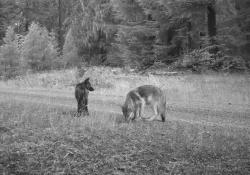 It's been nearly ten years since I saw my first wolves, high up in the Wallowa Mountains of NE Oregon. I was up there with Oregon Wild's Rob Klavins looking for the Imnaha pack and by good luck came up close to eight of them, led by OR3. I like to think one was OR7.
It's been nearly ten years since I saw my first wolves, high up in the Wallowa Mountains of NE Oregon. I was up there with Oregon Wild's Rob Klavins looking for the Imnaha pack and by good luck came up close to eight of them, led by OR3. I like to think one was OR7.
It wasn't until next year that he left on his legendary journey to California and then back to southern Oregon where he founded the Rogue pack - the first pack West of the Cascades since the mid-1900s.
He was an extraordinary wolf, like his father OR4. I think all wolves are extraordinary, but OR7 highlighted in gold the prodigious qualities of endurance, grit, perseverance, courage, and intelligence required to traverse thousands of miles of often hostile country, overcoming a legion of lethal obstacles created by humans.
He did this, and then founded a pack to boot. He garnered the love, respect and admiration of people all over the world. He put heart into those like myself who wanted wolves to regain their lost place in Oregon. He propagated generations of wolves now and in the future who will reclaim their heritage, and by so doing help restore a ravaged landscape.
I'll miss OR7...
Joanie Beldin, Co-Founder - WolfWays Wolf Education Program
When I learned that OR7 had likely passed and I knew this day would probably come soon, it still hit hard.
Losing him was like losing a family member because OR7 was a part of the WolfWays family. WolfWays is a wolf education program. The story of OR7 and his travels became the grand finale of every program we gave from pre-schoolers to adults. The kids knew him better as Journey. Over the years, more that 8,000 kids learned his story and fell in love with him. He was the star.
The resounding theme in the thank you notes we received was "My favorite part was when we learned about Journey". To share a few comments:
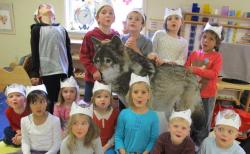 "I learned that Journey had so many journeys and one day he found his love."
"I learned that Journey had so many journeys and one day he found his love."
- "I loved the story of OR7. It was so interesting that a wolf would travel over a whole state just to find a mate!"
- "The story about Journey was very heartwarming and sad."
- "I love the story about Journey. He is a powerful and beautiful wolf"
- "I really enjoyed getting to hear about Journey's story and about how far he walked to find a wife".
Journey's story was an inspiration - he was the wolf who never gave up and finally found what he was looking for against all odds. It's been said that OR7 was an ambassador for all wolves. I've believed this to be true as I've seen the student's love for Journey translate into their caring for wolves.
Journey may have taken his final journey, but he will always be with us. He will always be a part of the WolfWays family. We will never stop telling his story. He will always be the star.
Bonnie MacRaith, Volunteer with EPIC - Environmental Protection Information Center, Arcata, CA
My experience with Journey was like an explosion in my heart … in the best of ways!
His intrepid travels reminded us all of our own Courage and Fearlessness. His presence in California was a lightening rod to many to work hard to get Endangered Species Protection for Wolves in California in 2014. And we got it!
The comments I heard at the Wildlife Fish & Game Commission hearings here in Humboldt County were so heart-felt and revealing. I heard a chorus of well-wishers for Wolves, enumerating the benefits of their presence in the Wild.
As OR-7 famously traveled out into the world the life of the Wolf became a new learning experience for us all. Even though he couldn’t read the news about himself it’s as if he knew he had accomplished a big thing as he was happy to finally live a quiet wolf’s life amongst his family in southern Oregon.
Many Blessings to you, OR-7, may your spirit rise and rise!
|
Do you have a story you want to share? Do you have thoughts on Journey’s legacy or how he affected you? If so, shoot me an email at [email protected]. I’ll post some of them here. |

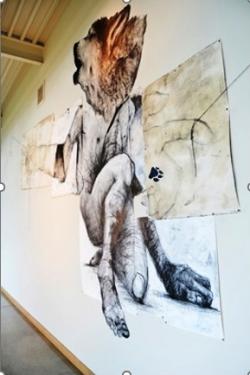 Andrew Myers created this art installation of OR7 called Where-Wolf. It is shown here at Willamette University in 2014.
Andrew Myers created this art installation of OR7 called Where-Wolf. It is shown here at Willamette University in 2014. 